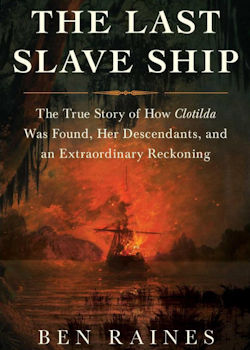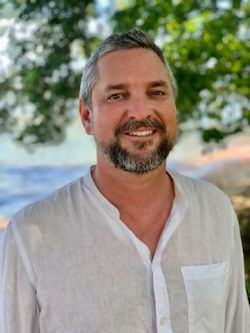SEJournal Online is the digital news magazine of the Society of Environmental Journalists. Learn more about SEJournal Online, including submission, subscription and advertising information.
BookShelf: Environmental Journalist Recounts His Historical Slave-Era Find
“The Last Slave Ship: The True Story of How Clotilda Was Found, Her Descendants, and an Extraordinary Reckoning”
By Ben Raines
Simon & Schuster, $27.99
Reviewed by Tom Henry
 |
Let’s put this out there: This book by a long-time environmental reporter is one primarily of history, not the environment.
But that’s OK. Not just because it provides a remarkable story of how Clotilda, the last ship from Africa carrying slaves to the United States, was recently found after it was set on fire and left to sink in Alabama’s Mobile River in 1860 with approximately 100 slaves on board (most of whom survived).
But also because there’s a big-picture lesson here for environmental writers: Keep your eyes, ears and heart open. You might just stumble upon something that contributes significantly to mankind, such as one of the nation’s most important historical artifacts. And you might get to use your environmental reporting chops to tell the story, as Raines does here.
In the case of Ben Raines, that was the remnants of a ship whose owner, Timothy Meaher, had tried to erase its history to cover up his crime of transporting slaves to the United States 50 years after the Atlantic slave trade had been outlawed.
A storyteller at heart
Raines, for many years a Mobile-area newspaperman and an environmental writer, did his best to explain to his readers the difference between polychlorinated biphenyls, polyaromatic hydrocarbons and PFAS chemical compounds, for example, or why carbon dioxide and sulfur dioxide are different pollutants.
But like other environmental writers mired in heavy science, Raines tried not to fall victim to the nose-to-grindstone pitfalls that come with being too myopic. He understood that’s only a part of our jobs, and that we also strive to be great storytellers focused on natural resources and the world around us.
Thus Raines was also a filmmaker, photographer and boat captain. And like many of us, he has a fascination with water. His first book, “Saving America’s Amazon: The Threat to Our Nation’s Most Biodiverse River System,” was an amazing overview of Alabama waterways (read our BookShelf review).
And once he became aware of Clotilda, it turned into an obsession and life-changer (in the book’s acknowledgments about its discovery, for instance, he thanked his wife and son for supporting him “even when my hunt for the ship meant I’d lost my job at the newspaper I’d worked at for decades.”)
The rise of Africatown
But the story doesn’t end with Clotilda’s discovery in 2018. It only begins. Raines went to great lengths tracking down descendants of slaves to learn the story of those who had survived Clotilda’s voyage, who had nowhere to go once the ship got to Alabama and their emancipation later followed.
 |
| Author Ben Raines. Photo: Susan Raines. Click to enlarge. |
He even traveled to the ancient African kingdom of Dahomey in modern-day Benin to interview descendants of people familiar with Clotilda’s history. Their passion for telling the world about the story comes through, but so does some of their humor, such as when Raines — a white man coming at the time from Donald Trump’s America — is greeted by a group of locals on African soil with chants of “Obama! Obama!”
In the end, more than 30 of the Clotilda survivors banded together industriously to form their own community, known as Africatown, on the outskirts of Mobile. It included a church and school, and many homes. Raines described the creation of Africatown as a great feat of perseverance and skill in the Jim Crow-era South.
They even made a plea for more land from their former slave owner, and though it did not go well, Raines wrote, “Coming just weeks after the end of the Civil War, this moment was likely the first instance of freed slaves anywhere in the nation demanding reparations from their former masters. … This was their moment of self-determination, the moment they decided they would fight back and demand their due, even if it was risky.”
Africatown was thus formed when the newly freed Clotilda slaves decided they would stop saving for passage back to Africa and would instead pool their money together for land to recreate their homeland here.
Raines reconstructs Africatown’s heyday. By 1912, it was America’s fourth-largest community of predominantly African-Americans. Two of Africatown’s most famous residents were former New York Mets outfielders Cleon Jones and Tommy Agee, stars of the team’s 1969 World Series championship (Jones, in fact, was one of the many people who helped educate Raines about Africatown).
The cost of environmental racism
Raines also captures how the historic settlement was torn up and destroyed. Sadly, Africatown itself eroded over the decades because of highway projects and other development, including heavy industry.
This is where Raines does most of his environmental writing in this book, describing the environmental racism that destroyed Africatown and made lives miserable for those who clung to it.
He sets up this section by noting that Alabama ranks last today among states in money spent on environmental issues and “is widely regarded by industry trade groups as the most permissive state in the country when it comes to setting or enforcing pollution limits.”
But, according to Raines, the situation was even worse in the 1980s, which he said was “a time when environmental laws were essentially meaningless.”
‘Imagine living in a community where people tried
to wash their cars every day so the ash falling
from the sky wouldn’t eat the paint off so quickly.’
— Author Ben Raines
Africatown factories included some of the world’s most productive paper mills, but there was a cost. “Imagine living in a community where people tried to wash their cars every day so the ash falling from the sky wouldn’t eat the paint off so quickly,” Raines wrote.
Africatown native and ex-Marine Maj. Joe Womack remembered at a U.S. Human Rights Network meeting in 2014 that at times ash fell from the sky like snow. “You’d be eating a sandwich at school and you’d have to brush that ash off your sandwich while you were eating it,” he said.
Among other things, Raines wrote about how he believes the U.S. Environmental Protection Agency’s Superfund program failed residents of Africatown, and how many people were believed to have died from cancers from exposure to industrial chemicals, including those seeping from landfills.
The future of a relic of the past
Perhaps there’s a bit of irony in that a highly publicized weather pattern that is believed to be associated with climate change — the “bomb cyclone of 2018” — aided an environmental writer by temporarily lowering water levels enough for Raines to find what he first thought was Clotilda.
It turned out to be a different ship, but its age and the size of it convinced Raines he was getting close. He returned and discovered the actual Clotilda weeks later.
The discovery was kept secret for a year until the verification process was complete. On May 22, 2019, the Alabama Historical Commission announced that the wreckage of the Clotilda had been found. Archeologists are trying to determine how much of it can be recovered.
The ship has received international attention. It is the only one ever found that brought enslaved Africans directly to America (Raines notes that a piece of a slave ship about the size of a brick on display in the Smithsonian Institution’s National Museum of African American History and Culture is from a South African ship that sank in port in Brazil and has nothing to do with the U.S. slave trade).
“Having the burnt, rotten hull of the last American slave ship on display would instantly make Africatown one of the most important sites in the burgeoning Civil Rights tourism industry,” he argues. “To the community, having the wreck on display in a new museum is vital to both resurrecting Africatown’s declining fortunes and reconnecting the people living there to their own history.”
Tom Henry is SEJournal’s BookShelf editor, a member of the Society of Environmental Journalists’ Editorial Advisory Board and a former SEJ board member. He has covered environmental and energy issues for The (Toledo) Blade since March of 1993.
* From the weekly news magazine SEJournal Online, Vol. 7, No. 25. Content from each new issue of SEJournal Online is available to the public via the SEJournal Online main page. Subscribe to the e-newsletter here. And see past issues of the SEJournal archived here.












 Advertisement
Advertisement 



